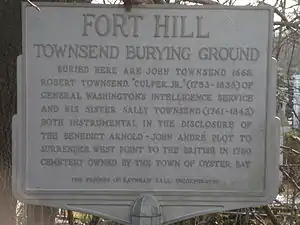John Townsend (Norwich)
John Townsend (1608–1668) was an early settler of the American Colonies who emigrated from England about 1630. Townsend was a signatory to the Flushing Remonstrance, a precursor to the United States Constitution's provision on freedom of religion in the Bill of Rights. Because of religious persecution under the Dutch authorities of New Amsterdam, many members of this family who were Quakers settled in Oyster Bay. There is no evidence in either Rhode Island or New York sources that John was a Quaker himself. John Townsend arrived in Oyster Bay in 1661 and it was there where he died and was buried in the Townsend Cemetery on his own land. Members of his family would go on to be distinguished leaders in the Oyster Bay community and on Long Island for centuries to follow.
John Townsend | |
|---|---|
| Born | Circa 1608 England |
| Died | 1668 Oyster Bay, Long Island, Province of New York |
| Nationality | English |
| Spouse(s) | Elizabeth (unknown)[1] |
| Children | John Townsend Captain Thomas Townsend |
| Parent(s) | (unknown) |
Biography

John Townsend was born about 1608 in England, however the names of his parents and the maiden name of his wife Elizabeth are not yet known.[3] [4] John and his brothers are in not related to Thomas Townsend of Lynn, MA and his family. Thomas did have a son named John who was born about 1644 and died in Massachusetts. [5] Old genealogies that did not have the access to records or YDNA testing that is available today often perpetuate this myth.
He was one of the original settlers of Flushing, having been granted a patent by Gov. Keift in 1645. [6] He and his brothers Henry Townsend and Richard Townsend settled there. Henry Townsend supported the Quakers which created political difficulties with the Dutch governor, Peter Stuyvesant, leading the Townsend brothers to move to Warwick, Rhode Island, where they became members of the Provincial Assembly.[7]
In 1656 Townsend and his brothers again attempted to settle in Long Island, this time obtaining the patent of Rustdorp (now Jamaica). Here too the Townsends came into conflict. John and Henry Townsend signed the Flushing Remonstrance on 27 December 1657.[8] Stuyvesant rejected the petition.
In the following year, 1658, Townsend moved with his brother Henry to Oyster Bay, which was out of the jurisdiction of the Dutch. Here he spent the remainder of his life, and died at Oyster Bay, in 1668.[7]
He was buried in Fort Hill in what was to become the Townsend Cemetery in Oyster Bay, New York. A stone with marker marks this site, with the words: "This stone marks the grave of John Townsend who came from England about 1630, and settled in Oyster Bay in 1661. He died in 1668. And was buried here on his own land." Having no will prepared, his wife Elizabeth in consultation with John Townsend's surviving brothers Henry and Richard, and John and her eldest sons John and Thomas Townsend, subdivided his property among surviving heirs on 10 May 1671.[2] John Townsend's wife Elizabeth died in 1684 and is also buried at the Townsend Cemetery[9]
References
- townsendsociety.org
- Oyster Bay town records, Volume I by John Cox, George William Cocks, 1916, p. 63.
- The Townsend Society of America, townsendsociety.org.
- Family Tree DNA, Townsend Project, YDNA database for Thomas Townsend of Lynn and the Oyster Bay Townsend brothers.
- Marcia Wiswall Lindberg, “Thomas Townsend of Lynn and his descendants for five generations,” The Essex Genealogist, 1993:13:152-155.
- American Ancestry, by Thomas Patrick Hughes, Frank Munsell (1887)
- Reynolds, Cuyler (1914). Genealogical and family history of southern New York and the Hudson River Valley. 3. New York, NY: Lewis Historical Publishing. p. 1108. Retrieved 11 June 2009.
- The Flushing Remonstrance is considered a precursor to the United States Constitution's provision on freedom of religion in the Bill of Rights.
- Historic Cemeteries of Oyster Bay Archived 2012-03-01 at the Wayback Machine, by John Hammond, February 2007